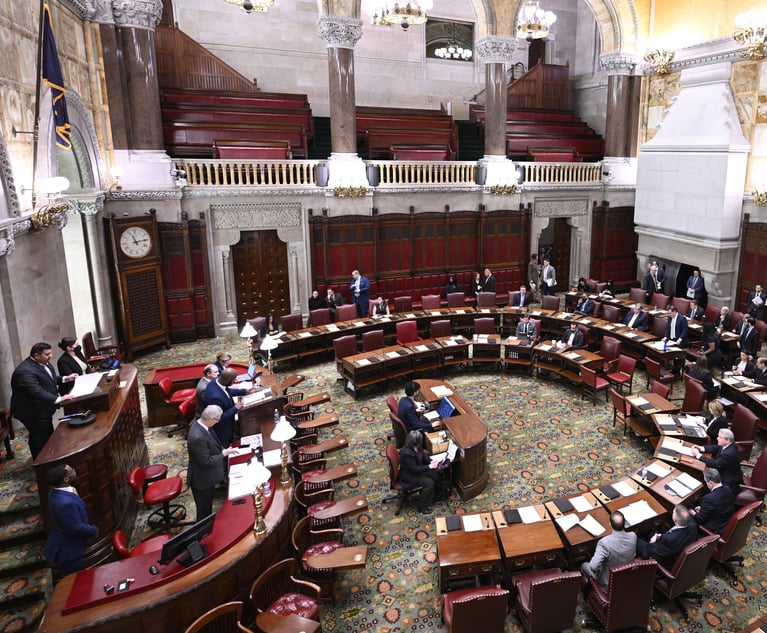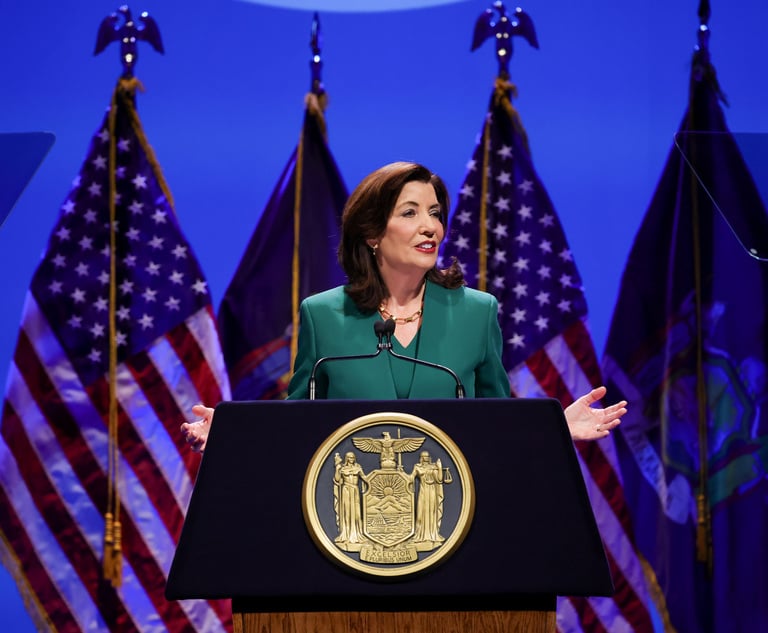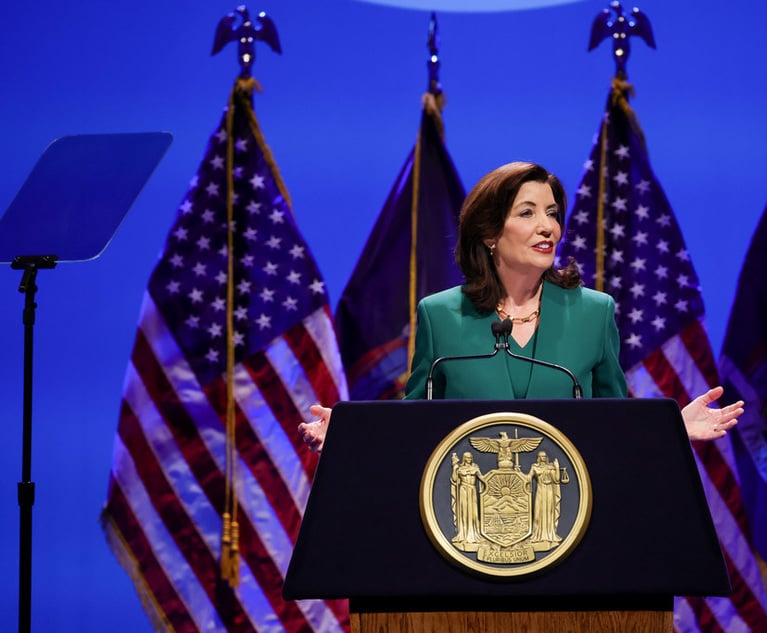Scanned Ballots Protected From Disclosure: 'Matter of Kosmider'
In their New York Court of Appeals Roundup, Lynn K. Neuner and William T. Russell Jr. discuss 'In the Matter of Kosmider v. Whitney', in which the Court of Appeals determined that there is no basis to distinguish between scanned images and paper ballots under Election Law §3-222, which restricts the disclosure of ballots for the two years after an election.
July 16, 2019 at 12:45 PM
8 minute read
 Lynn K. Neuner and William T. Russell Jr.
Lynn K. Neuner and William T. Russell Jr.
In In the Matter of Kosmider v. Whitney, the Court of Appeals ruled that scanned images of paper election ballots are protected from disclosure in response to a FOIL request. The majority determined that there is no basis to distinguish between the scanned images and the paper ballots themselves under Election Law §3-222, which restricts the disclosure of ballots for the two years after an election. A two-judge dissent disagreed and argued that, while the paper ballots are immune from disclosure under §3-222, that protection does not extend to the scanned images. While reaching opposite conclusions, both the majority and the dissent rely on the plain text of the Election Law and the public policy of preserving the sanctity of the election process.
Election Law §3-222 is part of a legislative scheme governing the preservation and safeguarding of information contained in election ballots. Its current enactment reflects the fact that voting in New York is now performed through electronic voting machines that require voters to mark a paper ballot by hand. The paper ballot is then scanned by the voting machine and automatically deposited into a secure box. The voting machine also stores an image of the ballot on two removable memory cards. One card remains with the machine, and the other card is sent to the applicable board of elections where its contents are preserved by transfer to more permanent electronic storage media.
Section 3-222 consists of three subsections. Subsection 1 provides that the memory cards shall remain sealed against reuse until the information on the cards has been preserved but that during that pre-preservation period, the data may be examined upon court order or the direction of a legislative committee conducting an investigation of the election. Subsection 2 provides that “[v]oted ballots shall be preserved for two years after [the] election and the packages thereof may be opened and the contents examined only upon” court order or direction of a legislative committee. At the end of the two-year period, the ballots “may be disposed of at the discretion of the officer or board having charge of them.” Finally, Subsection 3 similarly provides for the preservation of and restricted access to “protested, void and wholly blank ballots, open packages of unused ballots and all absentee and military, special federal, special presidential and emergency ballots and ballot envelopes” for two years except for “sealed packages of unused ballots” that only need to be preserved and restricted for four months.
One month after the November 2015 general election, petitioner Kosmider, chair of the Essex County Democratic Committee, requested from the Essex County Board of Elections the electronic copies of ballots stored by the County voting machines. The two Commissioners of the Board of Elections could not agree on the request and referred the matter to the County Attorney. The County Attorney treated the request as being made pursuant to FOIL, determined that disclosure was barred by §3-222(2), and denied the request. Petitioner appealed that denial to the County FOIL Appeals Officer who affirmed the determination. Petitioner then commenced an Article 78 Proceeding in June 2016 against the Commissioners and the FOIL Appeals Officer seeking an order directing release of the scanned copies of the ballots.
Supreme Court granted the petition and directed the release of the scanned ballot images. The Appellate Division, Third Department affirmed in a decision from which two Justices dissented. Respondents appealed as of right to the Court of Appeals.
In a decision written by Chief Judge Janet DiFiore and joined by Judges Eugene Fahey, Michael Garcia and Paul Feinman, the majority reversed the Third Department's affirmance and denied the petition. The majority noted that Public Officers Law §87(2)(a) exempts from disclosure under FOIL records that are “specifically exempted from disclosure by state or federal statute.” The majority determined that Election Law §3-222(2) prohibits the disclosure of scanned images as well as the paper ballots themselves and, accordingly, provides a FOIL exemption in this instance.
The majority decision explained that the plain text of a statute is the best indicator of the legislature's intent and that courts have even less flexibility in statutory interpretation of the Election Law where the Legislature enacted a “rigid framework of regulation” and where the sanctity of the electoral process can best be ensured through uniform application of the law. According to the majority, Election Law §3-222(2) makes clear a general default rule that public access to “voted ballots” is restricted for the two years following an election and may be permitted only upon a court order or direction from a legislative committee. The parties do not dispute that “voted ballots” include the actual paper ballots, and there is nothing in the text of the statute indicating that the legislature intended to treat electronic copies of those paper ballots any differently. Moreover, precluding access to paper ballots but permitting immediate access to copies of those ballots would permit a FOIL requester to easily circumvent disclosure restrictions simply by requesting a copy rather than the original. This approach did not make sense to the majority, particularly when materials provided in response to a FOIL request are always in the form of copies. The majority therefore found that protecting both paper ballots and their electronic copies is an integral component of the Election Law's closely regulated framework designed to promote the secrecy of the ballot and the integrity of voting and vote canvassing process. The majority also noted that the disclosure restrictions are not absolute, and the two-year limit on the protection as well as the provision permitting disclosure upon court order or legislative direction provide a necessary measure of transparency to the election process while still ensuring a measure of ballot secrecy and election finality.
Judge Leslie Stein, joined by Judge Jenny Rivera, issued a dissent that also relies on the plain language of the Election Law and the public policy of protecting the electoral process. The dissenters, however, focused more on the importance of open government and transparency in that electoral process, and determined that the scanned electronic images of paper ballots are not themselves “voted ballots” and accordingly are not subject to the two year sealing requirement of §3-222(2). The dissenters agreed with the majority that the plain language of a statute is the best indicator of legislative intent but drew the opposite conclusion from the majority as to what that plain language indicated. The dissenters noted that the term “ballot” is defined elsewhere in the Election Law as “that portion of the cardboard or paper or other material” containing the candidates' names, political affiliations and other information, Election Law §1-104(8), evincing an intent to limit “voted ballots” in §3-222(2) to the actual paper ballots themselves. While in certain circumstances it makes sense to provide the same level of protection to originals and copies, the dissenters argue that this is only true when the goal is to preserve the confidentiality of the document. In this instance, the dissenters explain, the goal is to prevent tampering with the ballots, which is not a concern with the preserved digitalized images in the possession of an election board. Accordingly, the dissenters would affirm the Third Department's decision.
Judge Rowan Wilson also dissented in a solo opinion in which he noted that the question of the Legislature's intent with respect to §3-222 is a close one. According to Judge Wilson, preserving the status quo and giving the Legislature time to state a different intent therefore counsels in favor of adopting the majority's view of §3-222(2). Judge Wilson nevertheless disagrees with the majority's result and would affirm the Third Department's decision because more than two years have passed since the election and no one claims that the paper ballots or their scanned images are still subject to the protections of §3-222(2). The majority rejects this argument on the grounds that it relies on subsequent events and on arguments not made or briefed by the parties.
By a single-judge majority, the Court of Appeals has ruled that scanned images of paper ballots are exempt from FOIL and may not be disclosed during the two years following an election absent court order or direction of a legislative committee. If that is not what the Legislature intended in enacting Election Law §3-222, it is now up to the Legislature to clarify its intent.
Lynn K. Neuner and William T. Russell Jr. are partners at Simpson Thacher & Bartlett.
This content has been archived. It is available through our partners, LexisNexis® and Bloomberg Law.
To view this content, please continue to their sites.
Not a Lexis Subscriber?
Subscribe Now
Not a Bloomberg Law Subscriber?
Subscribe Now
NOT FOR REPRINT
© 2025 ALM Global, LLC, All Rights Reserved. Request academic re-use from www.copyright.com. All other uses, submit a request to [email protected]. For more information visit Asset & Logo Licensing.
You Might Like
View All
Relaxing Penalties on Discovery Noncompliance Allows Criminal Cases to Get Decided on Merit
5 minute read
Bipartisan Lawmakers to Hochul Urge Greater Student Loan Forgiveness for Public-Interest Lawyers

'Playing the Clock'?: Hochul Says NY's Discovery Loophole Is to Blame for Wide Dismissal of Criminal Cases

So Who Won? Congestion Pricing Ruling Leaves Both Sides Claiming Victory, Attorneys Seeking Clarification
4 minute readTrending Stories
Who Got The Work
J. Brugh Lower of Gibbons has entered an appearance for industrial equipment supplier Devco Corporation in a pending trademark infringement lawsuit. The suit, accusing the defendant of selling knock-off Graco products, was filed Dec. 18 in New Jersey District Court by Rivkin Radler on behalf of Graco Inc. and Graco Minnesota. The case, assigned to U.S. District Judge Zahid N. Quraishi, is 3:24-cv-11294, Graco Inc. et al v. Devco Corporation.
Who Got The Work
Rebecca Maller-Stein and Kent A. Yalowitz of Arnold & Porter Kaye Scholer have entered their appearances for Hanaco Venture Capital and its executives, Lior Prosor and David Frankel, in a pending securities lawsuit. The action, filed on Dec. 24 in New York Southern District Court by Zell, Aron & Co. on behalf of Goldeneye Advisors, accuses the defendants of negligently and fraudulently managing the plaintiff's $1 million investment. The case, assigned to U.S. District Judge Vernon S. Broderick, is 1:24-cv-09918, Goldeneye Advisors, LLC v. Hanaco Venture Capital, Ltd. et al.
Who Got The Work
Attorneys from A&O Shearman has stepped in as defense counsel for Toronto-Dominion Bank and other defendants in a pending securities class action. The suit, filed Dec. 11 in New York Southern District Court by Bleichmar Fonti & Auld, accuses the defendants of concealing the bank's 'pervasive' deficiencies in regards to its compliance with the Bank Secrecy Act and the quality of its anti-money laundering controls. The case, assigned to U.S. District Judge Arun Subramanian, is 1:24-cv-09445, Gonzalez v. The Toronto-Dominion Bank et al.
Who Got The Work
Crown Castle International, a Pennsylvania company providing shared communications infrastructure, has turned to Luke D. Wolf of Gordon Rees Scully Mansukhani to fend off a pending breach-of-contract lawsuit. The court action, filed Nov. 25 in Michigan Eastern District Court by Hooper Hathaway PC on behalf of The Town Residences LLC, accuses Crown Castle of failing to transfer approximately $30,000 in utility payments from T-Mobile in breach of a roof-top lease and assignment agreement. The case, assigned to U.S. District Judge Susan K. Declercq, is 2:24-cv-13131, The Town Residences LLC v. T-Mobile US, Inc. et al.
Who Got The Work
Wilfred P. Coronato and Daniel M. Schwartz of McCarter & English have stepped in as defense counsel to Electrolux Home Products Inc. in a pending product liability lawsuit. The court action, filed Nov. 26 in New York Eastern District Court by Poulos Lopiccolo PC and Nagel Rice LLP on behalf of David Stern, alleges that the defendant's refrigerators’ drawers and shelving repeatedly break and fall apart within months after purchase. The case, assigned to U.S. District Judge Joan M. Azrack, is 2:24-cv-08204, Stern v. Electrolux Home Products, Inc.
Featured Firms
Law Offices of Gary Martin Hays & Associates, P.C.
(470) 294-1674
Law Offices of Mark E. Salomone
(857) 444-6468
Smith & Hassler
(713) 739-1250






